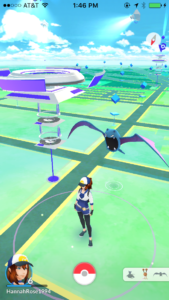On July 6, amongst global protests against police shootings, a little game called Pokémon Go quickly took over the world.
The augmented reality (AR) experience, created by Niantic, uses GPS to let players capture Pokémon around their city and pick up supplies at Pokéstops, which are real world landmarks. After reaching a certain level, players’ avatars can battle it out in gyms, which might just be someone’s house. The game’s success in the United States, Australia and New Zealand (the three countries where it’s currently available) is already clear. On July 8, only two days after its release, it had been installed on 5.16% of Android devices in the U.S. It is currently No. 1 in the Apple app store.
According to SimilarWeb, “as of July 8th, the app was being used for an average of 43 minutes, 23 seconds a day, higher than Whatsapp, Instagram, Snapchat, and Messenger.”
Clearly, the game will be a push for other AR projects: Nintendo’s stock increased almost 25% in Tokyo today. But while it highlights the potential of the technology, it also raises the question of where the focus on AR development should be. On one hand, Pokémon Go can be viewed as simply childhood nostalgia revitalized with 21st century technology. It’s easy to argue there isn’t much depth or any important social message (besides encouraging people to get off their couches and walk around). But it also hasn’t done much harm. So far, it seems the worst that the game has led to was a series of armed robberies and legitimate concerns about people walking around staring at their phones.
What makes AR so powerful is its simplicity and accessibility. Compared to virtual reality (VR) games that require goggles or other forms of immersive technology.
Most significantly, Pokémon Go arguably encourages the same sort of social action through experiencing the world through an augmented perspective. It takes the video game experience, one long restrained to a television or computer screen, outdoors. It’s not a hard game. To win, you simply have to interact with your environment: finally discover the weird mural or cultural monument you walk past every morning that is now a Pokéstop or find a new park that is also a gym.
Even more, the game encourages interaction. While it is simply more fun to play with friends, it is also a way to meet people. See someone walking at a brisk pace who suddenly stops, a small smile on their face? They probably just caught a Pikachu. Having played the game for less than 24 hours, I’ve already talked to more strangers than I ever have living in New York City.
Walking out of the subway last night, a group of people all immediately pulled out their phones, looking for a close Pokéstop. We ended up walking there together, showing off the Pokémon we had collected and sharing tips on how to level up (I am currently a Level 6, for the record.)
And with Pokémon Go popularity is only increasing, especially as it rolls out in other countries, it’s clear that the collective experience of playing Pokémon Go will only grow. This last week has shown the power of people gathering together and bonding over a common cause, with #BlackLivesMatter protests around the world. But it’s also shown the violence of existing in the public sphere, specifically for people of color.
In his piece “Pokémon Go Could Be A Death Sentence For A Black Man,” Omari Akil describes his experience playing the game:
“I spent less than 20 minutes outside. Five of those minutes were spent enjoying the game. One of those minutes I spent trying to look as pleasant and nonthreatening as possible as I walked past a somewhat visibly disturbed white woman on her way to the bus stop. I spent the other 14 minutes being distracted from the game by thoughts of the countless Black Men who have had the police called on them because they looked “suspicious” or wondering what a second amendment exercising individual might do if I walked past their window a 3rd or 4th time in search of a Jigglypuff.
When my brain started combining the complexity of being Black in America with the real world proposal of wandering and exploration that is designed into the gameplay of Pokémon Go, there was only one conclusion. I might die if I keep playing.”
While Pokémon Go is just a game, it lies in a limbo: it’s escapist, but connected to the world around you. Of course that’s the goal of AR. It’s reality, but an augmented version.
Even if Pokémon Go exists in a fantasy world, there is something powerful, and very real, in its ability to create human bonds. Arguably, its popularity doesn’t come from finding a rare Pokémon or winning a battle. It’s adding that magic to the everyday: a battle on the commute to work or catching a Bulbasaur walking to school, that makes it special.
Though what if this battle is used for understanding other people’s situations? What is if we use this incredibly engaging technology to make this world more empathetic? With the Washington Post we created a piece on the death of Freddie Grey, the purpose was to use the available court documents and testimony to accurately explain the series of events leading to his death in April, 2015. The 3D imaging allows users to explore the scene, bringing it to life. Try it out on our ARc Stories App, which will soon have new stories and let us know if this could be an alternative to catching 3D animals.




